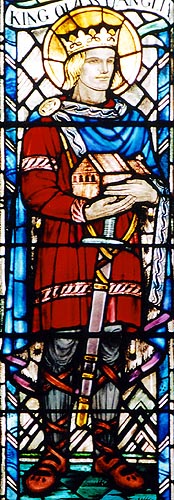 |
 |
|||
|
|
 St.
Aethelbert of East Anglia, St.
Aethelbert of East Anglia,King of East Anglia (AD 779-794) Aethelbert was the son and successor of Aethelred, King of East Anglia. He came to the throne very young, at the time that the powerful Offa was King of Mercia. Offa was, in many things, a good and just ruler, but he was guilty of a single act of treachery towards Aethelbert, apparently prompted by his wife, Cwendreda. The young prince, disregarding the forebodings of his mother, came to the Court of Offa at Sutton Walls, in Herefordshire, to seek the hand of his beautiful and pious daughter, Etheldreda. Offa received him with great respect and hospitality; but the Queen, Cwendreda, was full of ambitious schemes. She took the King to one side and exclaimed, "Look, your enemy has been delivered into your hands. He whose kingdom you have so long coveted. Now destroy him secretly and his kingdom will be yours and your heirs forever." The King hesitated. Traditionally Aethelbert's head was struck off on 20th May AD 794, but Matthew of Westminster tells another tale. He says that the Queen placed a richly adorned chair in the bedroom of the young King, over a trap door in the floor, and, on the chair, she placed a number of silk cushions. The young man, on reaching his room after a banquet, flung himself into the chair. The trap immediately gave way and he was precipitated into a vault where some of the Queen's servants were stationed; and they quickly suffocated him with the silk cushions. It can hardly be doubted that Offa was privy to the commission of the murder. He certainly lost no time in taking advantage of it, for he sent troops into East Anglia and annexed it at once to his own possessions. Then, as usual, he built churches and monasteries to atone for his wickedness, especially St. Albans Abbey and Hereford Cathedral. The later was dedicated to St. Aethelbert and was the place of his burial. Some say that Offa went a pilgrimage to Rome. At any rate, he gave much to churches in that city and especially to the English school there. Ealfreda, abhorring the crime that had been committed by her parents, retired to Crowland Abbey, where she spent forty years in seclusion and died in the odour of sanctity. Edited from S. Baring-Gould's "The Lives of the Saints" (1877).
|
|||
| © Nash Ford Publishing 2001. All Rights Reserved. | ||||


